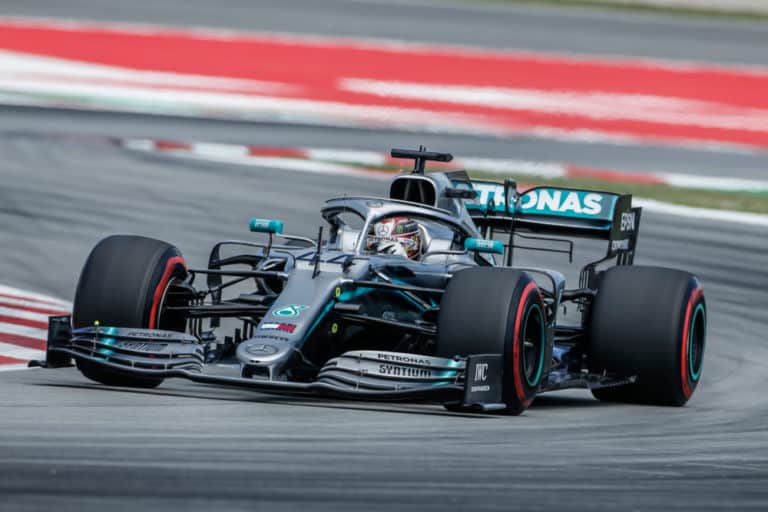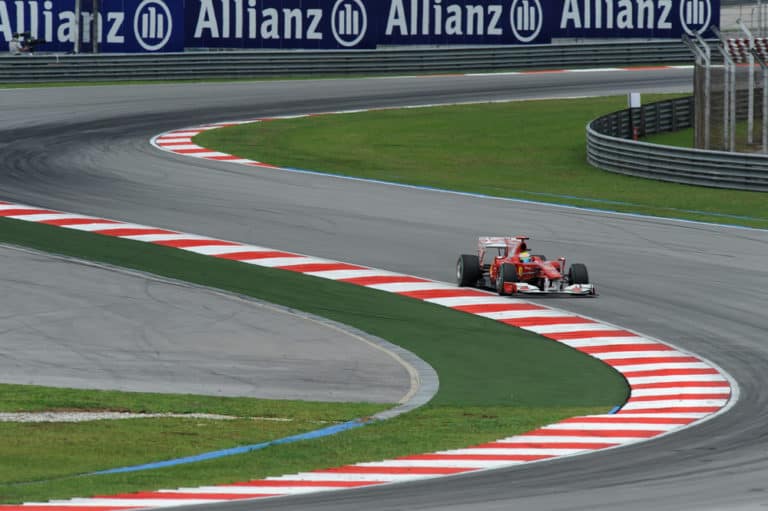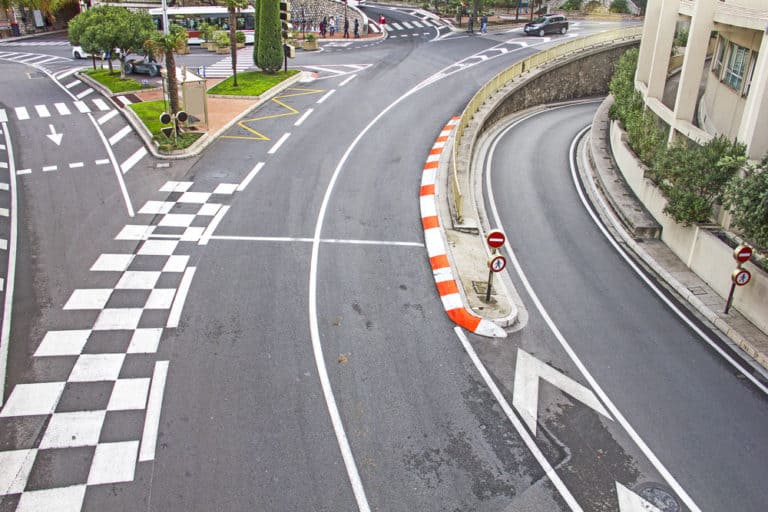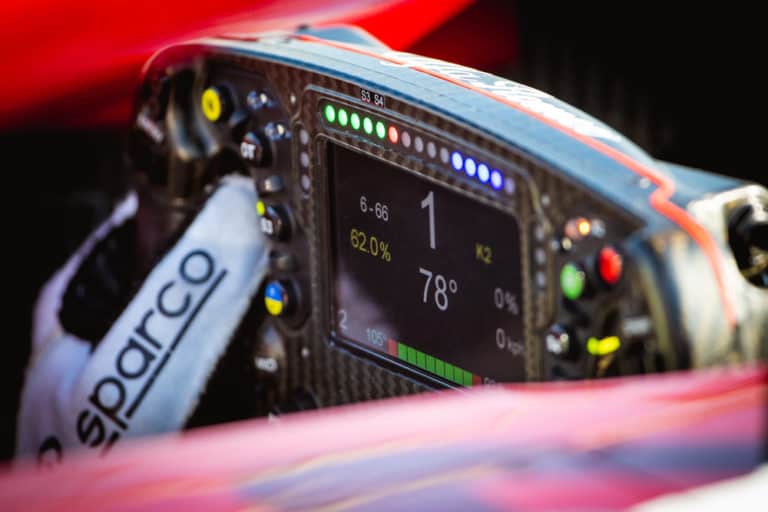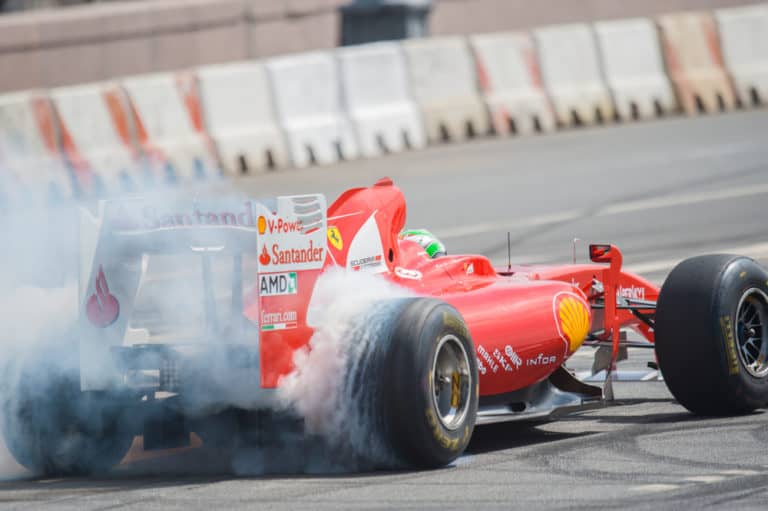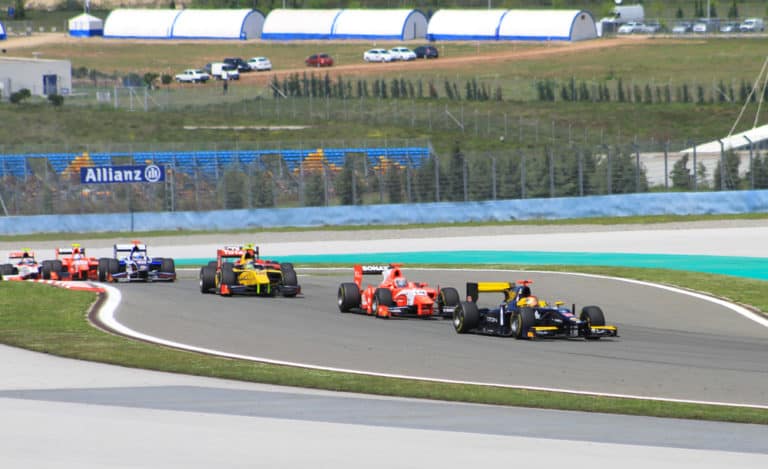Did you ever wonder what F1 tires are made of? Tires play a crucial part in F1 racing. They have a complex design; F1 drivers need a good understanding of their tires to achieve optimum speed and wear. Let’s look at what F1 tires are made of.
F1 tires have a complex design. They are made from a mix of synthetic rubber, natural rubber, and other fibers. Each compound added offers a different performance characteristic. The tires are constructed layer by layer and then cured in a press under high heat and pressure to form the tire.
F1 racing tires are highly specialized and designed to withstand various race track and weather conditions. This article looks at how F1 tires are constructed to help you understand how they are made.
If you’re looking for some F1 merchandise, check out the awesome stuff at the official F1 store here.
The F1 Tire
As with any part found on an F1 race car, its tires are carefully designed and manufactured to provide the best performance to the driver. F1 tires are constructed from a combination of rubber compounds and special fibers.
F1 tires underwent drastic transformations since the beginning of F1 racing in the 1950s. Since then, there have been several tire manufacturers, and many of them played vital roles in developing F1 tires like Goodyear, Bridgestone, and Continental.
But in 2011, Pirelli became the main supplier of F1 tires and had an exclusive agreement with F1 that allows them to be the sole and official supplier of F1 tires.
Five tire types were used during the 2020 race season: hard, medium, soft, intermediate, and wet. The F1 tire’s sidewalls are colored in white, yellow, red, green, and blue to distinguish the different types.
According to regulations, Pirelli has to announce a few months in advance what type of rubber compound they will use to manufacture the next season’s tires. The compounds used to manufacture the tires are mixed specially for each racing season.
F1 Tire Compounds Explained
F1 tires are complex in design and manufacturing and undergo several strict safety tests before being approved. The rubber compound used in constructing an F1 tire consists of four compounds set by FIA regulations highly specialized according to vehicle and race track conditions.
The F1 tire is a mix of several components that are layered and cured in a press under extreme pressure and high heat. The high temperature helps create a polymerization reaction that creates cross-link rubber molecules to create long elastic monomers that provide elasticity to the F1 tire.
These polymers create the elasticity that allows the F1 tire to be compressed, where the tire comes in contact with the track surface, allowing it to spring back to its original shape. Typical components used in F1 tire manufacturing are:
- Synthetic rubber or Styrene-butadiene co-polymer can be substituted for natural rubber.
- Polyisoprene or Natural rubber is the typical elastomer used in F1 tire manufacturing.
- Polybutadiene is often used in combination with other rubbers. It has a low heat-buildup.
- Zinc Oxide is added and acts as an activator to assist the vulcanization during manufacturing.
- Bromobutyl rubber is used for the tubeless inner liner compounds that offer low air permeability. Bromobutyl is superior to chlorobutyl but, unfortunately, more costly.
- Carbon Black is used in a high percentage of the rubber compounds that provide reinforcement and abrasion resistance to the F1 tires.
- Sulfur is added to facilitate the cross-link of rubber molecules in the vulcanization process during manufacturing.
- Silica is combined with carbon black to manufacture high-performance tires to offer a low heat buildup and reinforcement to F1 tires.
- Kevlar and Carbon fiber threads are used to reinforce the F1 tire.
- Vulcanizing accelerators are organic compounds added that help speeds up vulcanization during manufacturing.
- Antioxidants and antiozonants are added to prevent sidewall cracking due to natural exposure to the elements.
Compounding combines all the ingredients to mix the rubber compound used to manufacture an F1 tire. Each component consists of different combinations of ingredients according to the properties needed for that component.
The crucial parameter of a rubber compound reinforced with Carbon Black is the microdispersion of the filler, where the fine balance between these two components dictates the main properties of the finished F1 tire.
F1 Uses Pirelli Tires Only
F1 has had an agreement with Pirelli to be the sole supplier of F1 tires since 2011. F1 regulations state that all teams use Pirelli F1 tires only at races.
Before the 2011 agreement with Pirelli, Bridgestone was the main F1 tire manufacturer for four previous years. The exclusive agreement with Pirelli started in 2011 and has been extended through the 2023 season. Don’t expect Pirelli F1 tires to be going away anytime soon.
Before 2006, F1 went through a tire war where different tire manufacturers tried to negotiate with teams to become their tire manufacturers.
The tire war ended in 2006 when the FIA introduced tire regulations to reduce costs and level out the competition. If a team had an unlimited budget and a choice of multiple tire manufacturers, they could produce different tires for every race and gain an unfair advantage.
Top teams could get the best tires while teams with lower budgets could not afford the same tires, creating advantages and disadvantages.
The new FIA rule introduction gave every team the same tires. The changes in FIA tire regulations came soon after Ferrari’s dominance and were implemented to reduce the gap between the back of the track and the front of the track.
How F1 Tires are Made
F1 tires manufactured by Pirelli start their journey in the laboratories where research is conducted into different combinations of compounds and structures to form the tires. Computer simulations allow engineers to develop F1 tires that meet FIA specifications.
The F1 tires are constructed of a combination of artificial fibers, synthetic and natural rubber. Prototypes are built and tested and then undergo extreme tests and simulated weather conditions encountered during a race. Whereafter the tires are tested on the track before being approved for production.
The initial part of the manufacturing process is to produce the bead wire and body of the tire while the belt and tread are simultaneously made. When all these components have been assembled, the tire undergoes vulcanization, where it is placed in an oven and heated to form the characteristics of that particular rubber compound.
Every F1 tire undergoes strict quality controls, x-ray scans, visual checks, and weighing. A sample tire is randomly chosen for destructive tests to determine how the tire behaves in extreme circumstances.
Every F1 tire has a barcode that allows it to be tracked from manufacturing, to which team receives it, to how many laps it runs on the track. It takes approximately five hours to manufacture each F1 tire.
Typically, F1 tires are filled with nitrogen which is more stable than air. Nitrogen behaves predictably even when the temperature varies.
F1 Tire Strategy
F1 uses different tire compounds, consisting of slick tires and wet weather tires. Three of the slick tire types are used per race and are labeled as soft, medium, and hard.
Each F1 car must use at least two of these tires during a dry race. Before 2020 the F1 tires were color-marked, with a white stripe on the hard, a yellow stripe on the medium, and a red stripe on the soft tire. Since 2020 the compounds were labeled C1, C2, C3, C4, and C5, with C1 being the hardest and C5 the softest.
The F1 tires range in softness, but the teams must balance the need for soft, quick tires with a short lifespan with the durability of the hard slower tires.
This delicate balance is the basis of the F1 tire strategy and can make or break an F1 driver’s chance of achieving success during a race.
The wet F1 tire is grooved and can disperse approximately sixty-five liters of water a second going at full speed. In comparison, the intermediate tire is more suitable when there is rain without standing water. The intermediate F1 tire does extremely well on a damp track and can substitute as a crossover tire between slicks and a grooved wet tire.
F1 drivers who qualify in the top ten must start the race on the set of tires used to set their fastest time in Q2. This gives the driver placed in the 11th spot an advantage of starting the race on whichever tire he prefers.
Every F1 driver gets thirteen sets of F1 Pirelli tires per race weekend. And even though Pirelli decides which tire compounds will be used, the teams decide how many they choose of each compound.
The racing teams have to make their tire selection fourteen weeks for flyaway races and European races eight weeks in advance.
In the first eight races in 2020, all teams received two sets of hard tires, three sets of mediums, and eight sets of soft tires.
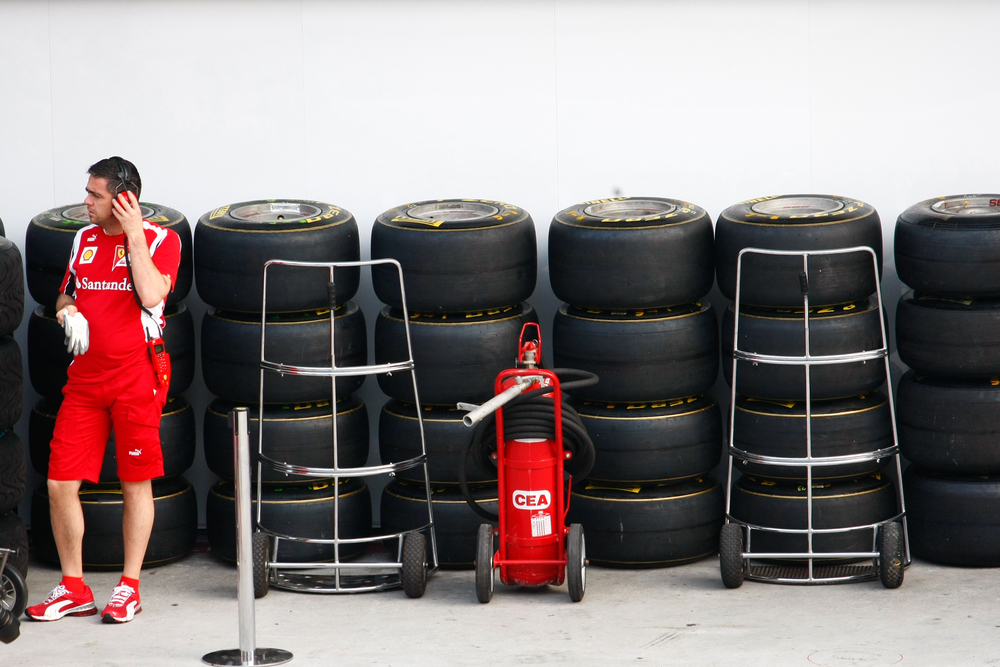
Tire Regulations
Each F1 team receives thirteen sets of F1 tires each race weekend. Pirelli keeps three aside for the race. The teams can use the other ten sets of tires during qualification and practice.
The F1 teams must make at least one pitstop and use two different compounds. Some tires are faster than others, but others are more durable, making it a delicate choice.
How Does Pirelli Decide Which Tire to Use at a Race?
Pirelli typically chooses soft, medium, and hard tires at every race; however, these compounds can range depending on what Pirelli chooses.
They look at the weather before deciding which tries to use. The temperature plays a vital part in choosing tires for a race. In hot weather, Pirelli typically chooses the harder tires.
The track also plays an important part in that decision; for instance, at tracks like Bahrain or Barcelona, you can see how teams are focused on choosing the right tires.
The wear and tear on the tires at these tracks are high. Pirelli typically goes for the harder tires at fast corners, where tires are under more pressure and during warm temperatures.
What Types of Pirelli F1 Tires are Used at an F1 Race?
At every F1 race, three different compounds are used from Pirelli from their supply of five dry-track slick tires. Since 2020, the schedule’s compounds have been labeled C1, C2, C3, C4, and C5, with C1 being the hardest and C5 labeled the softest. The characteristics of the F1 tires have changed from previous seasons. These days they are manufactured to increase resistance to overheating and provide better consistency on the track.
C1 Hard Tires
The slick hard tires are labeled C1 and are the hardest tire in the supply. The C1 is designed for circuits that put the highest energy loads through. That typically features abrasive surfaces, fast corners, and high temperatures. C1 tires take longer to warm up but offer great durability and low degradation. The C1 has a white color banded around the wall.
C2 Medium Tire
Pirelli’s C2 is effectively the previous season’s medium tire. The C2 is a versatile tire but slightly harder on the spectrum.
The C2 does well on high energy loads, high temperatures, and speed circuits and demonstrated great adaptability and working range on a wide variety of different tracks. C2’s have either a yellow or white band.
C3 Soft Tire
The C3 tire is similar to the soft tire used during previous seasons. C3 maintains a good balance between durability and consistent performance. The C3 is an adaptable tire that can be used as the softest tire at a high-severity track. And as the hardest tire at a street circuit or low-severity track. The C3 has three different options of color banding, yellow or red or white
C4 Ultra Soft Tire
The C4 is the closest to the previous season’s ultrasoft tire and does great works on tight tracks. The C4 has a rapid warm-up and high peak performance. Unfortunately, the C4 is relatively limited in overall durability. Fortunately, this season’s compounds’ improved design and consistency mean the softer rubber is capable. The C4 Ultra soft has red or yellow banding.
C5 Hyper Soft Tire
Pirelli’s C5 is the softest tire. The popular hypersoft C5 is the fastest tire Pirelli ever manufactured. The C5 is suitable for tracks that demand high levels of mechanical grip. The short lifespan is a trade-off for the extra speed and grip. Getting the most out of the C5 is key to race tire strategy.
Wet / Intermediate
The intermediate and wet F1 tires have been redesigned with new structures and tread patterns to be more versatile and efficient. There are no longer two specifications of intermediate and wet and tire since 2020.
There is only one wet tire and one intermediate tire for all weather conditions and circuits from now on. The colors remain unchanged; they continue to be branded Cinturato, unlike the slick tires, which are labeled C1 to C5.
Conclusion
F1 tires are the most crucial part of an F1 car. The tires are the only part that has contact with the track.
The designing and manufacturing of F1 tires are complex. Extensive research goes into manufacturing to combine all the ingredients to mix the rubber compound used to manufacture an F1 tire. Each component consists of different combinations of ingredients according to the properties needed for that component. Pirelli has been manufacturing F1 tires since 2011 and will do for the foreseeable future.
The team strategists and drivers often contemplate which tires are the best to use on a certain track or weather conditions.
Typically, the team decides what compounds they will be using at which races during a season in advance. That choice depends on several factors, from the state of the track surface, track temperature, and weather conditions. Great F1 tires are essential to a driver’s success during a race.
Sources
- https://www.pirelli.com/global/en-ww/race/where-f1-car-tyres-come-to-life
- http://www.formula1-dictionary.net/tire_compound.html
- https://www.motorsport.com/f1/news/who-makes-f1-motogp-indycar-tyres/6693087/
- https://www.racefans.net/2019/02/05/five-compounds-three-colours-pirelli-explains-tyre-test-labelling/
- https://www.redbullracing.com/int-en/bulls-guide-to-tyres

